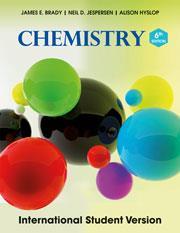Matthew Almond reviews the new edition of this undergraduate textbook
Chemistry (6th edn)
James Brady, Neil Jespersen, Alison Hyslop
John Wiley & Sons 2011
1232pp | £54.99 (pb) | ISBN 9780470646175

This is the sixth edition of a well-established textbook, but one that is probably more familiar in the US than in the UK. It aims to be a general chemistry text for students starting on university level chemistry courses.
The authors have set themselves three clear goals in producing this book: first, to strengthen the connection between macroscopic observations and the microscopic behaviour of atoms and molecules, secondly, to enhance problem-solving skills in students and finally to integrate with the on line resources available from the publishers at WileyPLUS. These are sensible aims but to me the book does not quite reach the right level for UK students.
Chapter one is a good case in point where the atomic and molecular view of matter is described. The material here might be useful revision for some students but it is well below the level that is taught in first year university courses. These concepts are, however, developed further in chapter ten where theories of bonding are considered and this does lead on eventually to molecular orbital theory which is a significant part of first year university chemistry teaching in the UK.
In fact, physical chemistry is covered quite well, although a large amount of the material is below the level taught in UK university courses. However, the book is very weak in inorganic and organic chemistry. In an 1100 page book, organic chemistry is covered only in pages 1047-1085 and inorganic chemistry is relegated to a discussion of nuclear reactions and metal complexes.
Features that I like are the ‘multi-concept problems’ and ‘exercises in critical thinking’ - mainly in physical chemistry - at the end of each chapter. Some of these would get the students to think and would provide useful discussion topics for tutorials and seminars.
My overall view of this book is that it could provide useful background reading in physical chemistry for both A-level and first-year university students. I do not think, however, that it would be useful as a textbook for most UK university courses because of the general level of much of the material and the very small amount of organic and inorganic chemistry covered.
Purchase Chemistry (6th edn) from Amazon.co.uk






No comments yet